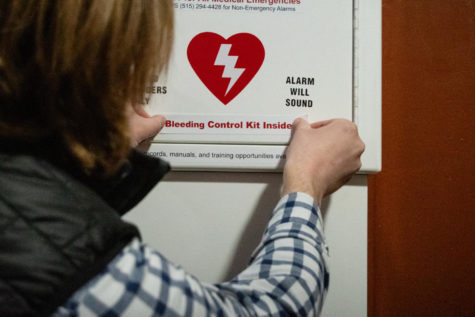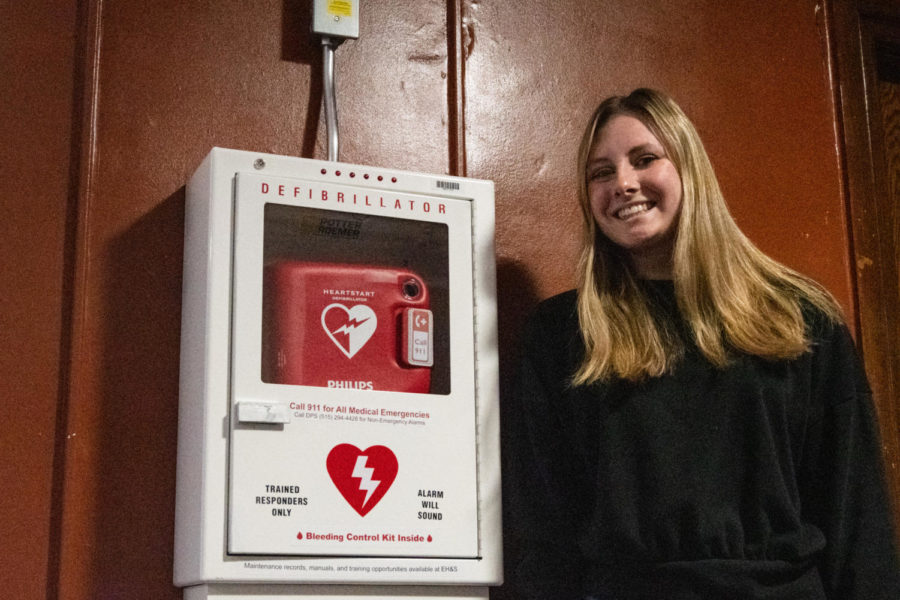Student request prompts installation of extra AEDs in residence halls
Addison Salski places the new AED into the storage compartment in Birch Hall on Feb. 15, 2023.
For many people, a racing heart is a representation of the tense nerves brought on by a job interview or the rushing excitement of a first kiss. For Addison Salski, a racing heartbeat could be a sign of immediate danger.
Salski, a student with a heart condition and a sophomore majoring in music, prompted the university to install eight new automated external defibrillators (AEDs) in Iowa State’s residence halls. The first of these was installed in her own dorm, Birch Hall, at 2:30 p.m. Wednesday.
A representative from the Department of Environmental Health and Safety (EHS) placed the required labels and stickers onto the AED cabinet, which was set up ahead of time, but Salski was given the honor of placing the actual AED onto its new perch.
“To see this actually come through and to physically put [the AED] in, I was like ‘Wow, something that’s really important to me and that I’m passionate about is making a difference,’” Salski said. “It’s such a blessing to be part of this.”
The seven other AEDs will be installed on a rolling basis as their cabinets are hooked up to the proper alarms and electricity. Some of the locations they will be at include the Maple-Willow-Larch and Barton-Lyon-Freeman buildings.
Salski’s request for additional AEDs began as a personal observation of how far she would have to travel for an AED as a resident of Birch Hall’s third floor. Last semester, the closest AED was on the first floor of Roberts Hall, which is another dorm connected to Birch.

The new AED Salski helped install is located on the second floor of Birch Hall next to one of the building’s east entrances.
Around the age of two, Salski was diagnosed with idiopathic ventricular tachycardia, a condition that causes a rapid heartbeat. If this heartbeat is sustained, it can lead to serious problems like fainting, loss of consciousness or cardiac arrest.
For Salski and other people who may experience an erratic heartbeat, having an AED nearby is a vital part of everyday health and safety.
AEDs are portable electronic devices that can be utilized for people experiencing irregular heart rhythms. When activated, they can analyze the heart’s rhythm and deliver an electrical shock to re-establish a proper rhythm.
In 2014, Salski’s parents founded Big Dreams for Little Hearts, a non-profit organization that raises money to donate AEDs to children with heart conditions to help their families feel more at ease.
Salski brought a similar mission to Iowa State when she voiced her concerns to her president’s leadership class in December 2022, the action that led her to make a request to EHS. Salski asked her classmates to raise their hands if they had seen an AED in their dorm, and none of them did.
“I think they were all shocked because they’ve never thought of it before,” Salski said. “They’ve never looked around for an AED.”
Some of Salski’s classmates questioned why it was important to address the university’s AED availability, but Salski stood her ground, noting that AEDs can help any person in need.
“Any student out there could go into cardiac arrest, so it’s not just about me,” Salski said. “I’ll be moving out of [Birch Hall], but somebody could move in next year and need this AED.”
President Wendy Wintersteen connected Salski with the Department of Residence and EHS a few days after Salski’s discussion with her classmates.
“I just keep thinking about how I never thought it would happen,” Salski said. “It was just purely an idea I brought to my class.”
AEDs were first placed in Iowa State’s residence halls in 2017 next to hall desks, but the Department of Residence and EHS both agreed this was not sufficient after discussing with Salski via email.

After evaluating other locations with long travel distances to the nearest AED, the Department of Residence and EHS decided to add eight new AEDs to make them more accessible in residence halls.
“When you work for the university, you kind of get used to things taking a long time […] so it’s really cool that we’re able to do this so quickly,” said Alex Wiley, a fire safety specialist with EHS who helped Salski install the first AED.
AEDs cost around $1,300, according to Salski, but the Department of Residence was able to fund the installation of each new device.
“One of the challenges going forward will be just maintaining funding to maintain all [the AEDs],” Wiley said.
AED pads need to be replaced every two years, and their batteries need to be replaced every two to five, according to Wiley.
Additional information on AEDs, including a location map and list, can be found on the EHS website.
Your donation will support the student journalists of the Iowa State Daily. Your contribution will allow us to purchase equipment, send our student journalists to conferences and off-set their cost of living so they can continue to do best-in-the-nation work at the Iowa State Daily.















